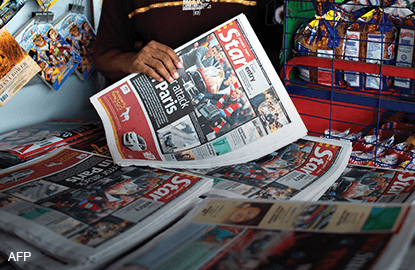
This article first appeared in The Edge Malaysia Weekly, on December 14 - 20, 2015.

STAR Media Group Bhd is believed to be in talks to hive off its loss-making radio station, Capital FM and Astro Malaysia Holdings Bhd is said to be among the interested parties, according to industry sources.
It is not known at what price Star Media intends to sell the radio station.
As a yardstick of the pricing of radio assets, Media Prima Bhd recently acquired two radio stations — Ultra FM and Pi Mai FM — for RM20 million. The multimedia group already had three radio stations — Hot.fm, Fly.fm and One.fm — in its stable before the acquisition.
While Star Media (fundamental: 1.80; valuation: 1.40) is looking for a suitor for Capital FM, there has been no decision on its other radio station, Red FM, although the announcers have been told their last day of work is the end of the month, sources say.
Representatives of Star Media and Astro declined to comment when contacted by The Edge.
Astro’s radio business is making money. Pre-tax profit grew 19% year on year (y-o-y) to RM116.9 million for its nine months ended Oct 31, 2015 (9MFY2015). The pay TV provider has a portfolio of nine FM radio brands — ERA fm, MY FM, hitz fm, THR Raaga, THR Gegar, SINAR FM, MIX fm, LiteFM and MELODY FM.
“It is not just about whether a particular radio business is making money … the value can also be in the licence. Someone can buy the licence and change the format of the station. What is important is the licence,” says a media analyst.
“The radio industry has always been growing. Consumer and adex [advertising expenditure] sentiments may be bad, but most advertisers will not move away from radio as it is a cheaper platform than TV and print. The only downside to radio is that the competition is too stiff.
“Operating a standalone station can cost RM15 million ... but if the cost is spread over, say, three or four stations, it can cost RM10 million per station as they share the same expenses, such as station towers and consoles, so there is a cost benefit.”
According to the results of a Radio Audience Measurement (RAM) survey released by Nielson last month, Malaysian radio listenership stayed high, with 93.7% of listeners aged 10 and above in Peninsular Malaysia tuning in to their favourite radio station. It also found that the quarter-hour audience is stable with an average of 1.7 million listeners.
Malaysians spend nearly 16 hours in a week listening to their preferred radio stations.
The Nielsen RAM survey also revealed that 79% of radio listeners live in urban areas and 62% are under the age of 40. Some 39% of respondents were the decision-makers for purchases of grocery items in their households and 51% listen to their favourite radio station during their daily commute.
“Radio continues to be a popular medium, as indicated by the high reach. Besides, radio exposure has proved to create a positive affinity for bottom line sales,” observes Benjamin Ting, executive director of Media Industry Group for Nielsen Malaysia, in the survey released in November.
“Based on a recent Nielsen sales effect study conducted in the US, which examined radio’s return on ad spend across four retail categories (department stores, mass merchandisers, home improvement stores and quick service restaurants), every dollar spent on radio advertising can generate up to US$17 in revenue from listeners exposed to radio ads.”
Meanwhile, aside from Capital FM and Red FM, which are English channels, Star Media has two other radio stations — the Chinese-language 988 FM and Malay-language Suria FM.
988 FM is the No 1 Chinese station in the northern region and has a listenership of 1.7 million nationwide.
Suria FM has 2.3 million urban-centric Malay listeners weekly nationwide.
Red FM has 325,000 listeners a week in Peninsular Malaysia while Capital FM — the only English radio station that is specifically targeted at urban English-speaking women — has 80,000 listeners a week in the Klang Valley and Penang.
“English radio stations are regarded as good to have, but it is the Malay and Chinese stations that are prized. The vernacular market is strong and expanding,” says a C-level officer at a listed media group.
Last week, The Edge Financial Daily reported that Star Media is reviewing its radio assets, which could possibly result in two radio stations, Red FM and Capital FM, ceasing operations.
“In view of the current challenges, like most other companies, Star Media Radio Group is reviewing and consolidating all its assets to continuously improve and better serve our most important stakeholder — our consumers,” Star Media Group told The Edge Financial Daily last week.
For the nine months ended Sept 30, 2015 (9MFY2015), Star Media’s radio broadcasting segment saw airtime revenue decline by 4% y-o-y to RM36.93 million, due to economic uncertainties and a challenging media environment.
“This segment recorded a smaller loss before tax of RM0.21 million in the current quarter as there were no amortisation costs on Capital FM’s radio licence in the nine months ended Sept 30. Full impairment loss on Capital FM’s radio licence was recognised in 4Q2014,” Star Media notes in its third-quarter results announcement.
Save by subscribing to us for your print and/or digital copy.
P/S: The Edge is also available on Apple's AppStore and Androids' Google Play.